The evacuation process began
on March 31 1942. The Japanese left their homes for assembly
centers directed by one of the 108 Civilian Exclusion Orders.
This was the first mass forced movement of its kind to be conducted
in America. Notices of evacuation were placed on telephone poles
and in store windows. These notices told the Japanese where to
report and when. "They were ordered to supply their own
'bedding and 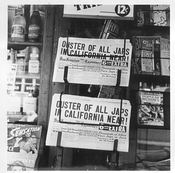 linen' (not a
mattress), 'toilet paper,' 'extra clothing,' 'knives, forks,
spoons, plates, bowls, and cups,' and 'essential personal effects'"
(Daniels
1993: 55). Many Japanese had no idea where they would be
going. Many did not even know they would first be sent to assembly
centers and then later transferred to permanent internment camps.
The government's lack of communication as well as its lack of
sensitivity only made the evacuation more
linen' (not a
mattress), 'toilet paper,' 'extra clothing,' 'knives, forks,
spoons, plates, bowls, and cups,' and 'essential personal effects'"
(Daniels
1993: 55). Many Japanese had no idea where they would be
going. Many did not even know they would first be sent to assembly
centers and then later transferred to permanent internment camps.
The government's lack of communication as well as its lack of
sensitivity only made the evacuation more
difficult. The Japanese were ordered to limit their bags to what
they could carry, but it was difficult to pack for a secret destination.
A majority of their personal possessions were left behind due
to necessity. "Real estate, cars, appliances, farm equipment,
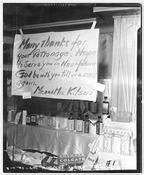 crops
ready for harvest, and personal possessions were sold for a fraction
of their worth or simply left behind in haste" (Nagata
1993: 7). The economic loss of the Japanese due to the evacuation
was immeasurable. Not only did the Japanese suffer economic loss
during the evacuation process but also while they were in the
camps. "The years of exclusion were frequently punctuated
by financial troubles: trying to look after their property without
being on the scene when difficulties arose; lacking a source
of income to meet tax, mortgage and insurance payments"
(Commission
on Wartime Relocation and Internment of Civilians 1997: 117).
It is difficult to assess the exact economic loss of the Japanese-Americans,
but both writers and commentators have cited an estimate by the
Federal Reserve Bank of San Francisco that evacuee property losses
ran to $400 million. (Commission
on Wartime Relocation and Internment of Civilians 1997: 120).
crops
ready for harvest, and personal possessions were sold for a fraction
of their worth or simply left behind in haste" (Nagata
1993: 7). The economic loss of the Japanese due to the evacuation
was immeasurable. Not only did the Japanese suffer economic loss
during the evacuation process but also while they were in the
camps. "The years of exclusion were frequently punctuated
by financial troubles: trying to look after their property without
being on the scene when difficulties arose; lacking a source
of income to meet tax, mortgage and insurance payments"
(Commission
on Wartime Relocation and Internment of Civilians 1997: 117).
It is difficult to assess the exact economic loss of the Japanese-Americans,
but both writers and commentators have cited an estimate by the
Federal Reserve Bank of San Francisco that evacuee property losses
ran to $400 million. (Commission
on Wartime Relocation and Internment of Civilians 1997: 120).
Once a notice of evacuation was posted a representative of each family would visit a control center where the family was registered and issued a number, told when and where to report and what could be taken along. The numbering process was particularly offensive to the Japanese:
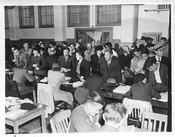
The Japanese met at bus and train stations where they were patrolled by armed guards. The train rides to the assembly centers often provided inadequate food and water. In some cases the train windows were blacked out which only aggravated the evacuees's feelings of uncertainty. Grace Nakamura recalled her trip:
On May 16, 1942 at 9:30 a.m., we departed . . . for an unknown destination. To this day, I can
remember vividly the plight of the elderly, some on stretchers, orphans herded onto the train by caretakers, and especially a young couple with 4 pre-school children. The mother had two frightened toddlers hanging on to her coat. In her arms, she carried two crying babies. The father had diapers and other baby paraphernalia strapped to his back. In his hands he struggled with a duffle bag and suitcase. The shades were drawn for the entire trip. Military police patrolled the aisles (quoted in Commission on Wartime Relocation and Internment of Civilians 1997: 136).
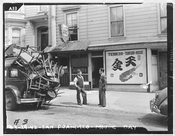
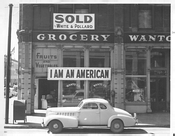
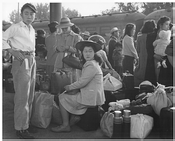 The Japanese literally had no idea where
they were going. All of the assembly centers were located in
areas with desert like conditions. Many centers were located
on previous race tracks and fairgrounds. The horse stalls and
animal shelters were converted to housing facilities. Although
the assembly centers were considered temporary the average stay
was three months. In May 1942 the Japanese were once again uprooted
and transferred to more permanent internment camps.
The Japanese literally had no idea where
they were going. All of the assembly centers were located in
areas with desert like conditions. Many centers were located
on previous race tracks and fairgrounds. The horse stalls and
animal shelters were converted to housing facilities. Although
the assembly centers were considered temporary the average stay
was three months. In May 1942 the Japanese were once again uprooted
and transferred to more permanent internment camps.